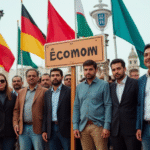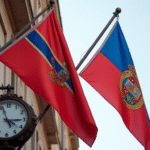Introduction
On the previous Monday, Claudia Sheinbaum, as Mexico’s first female president, led the Grito de Independence ceremony, marking a significant milestone in this civic act that has been used since Porfirio Díaz to reaffirm unity, sovereignty, and political legitimacy.
Sheinbaum’s Historic Grito
Sheinbaum passionately shouted the traditional phrases: “¡Viva la Independencia!”, “¡Viva Hidalgo!”, “¡Viva Morelos!”, “¡Viva Allende!”, “¡Viva Guerrero!”. She went a step further by including Josefa Ortiz, addressing her as “Josefa Ortiz Téllez-Girón,” using her maiden name instead of Domínguez, thus breaking free from the old patriarchal custom of subordinating a woman to her husband’s surname. Alongside Ortiz, Sheinbaum acknowledged Leona Vicario and two nearly forgotten figures: Gertrudis Bocanegra, an insurgent in Michoacán captured, tortured, and executed in Pátzcuaro in 1817; and Manuela Molina la Capitana, who took up arms in Tabasco. She also invoked unnamed heroines, indigenous women, and migrants, concluding with universal values: “¡Viva the dignity of the Mexican people! ¡Viva liberty! ¡Viva equality! ¡Viva democracy! ¡Viva justice!”
Symbolic Significance
The symbolic weight of Sheinbaum’s actions was twofold. First, she feminized the narrative of Mexican independence, as women were barely mentioned before, except for Ortiz and later Vicario. The president broke this tradition by opening space for overlooked insurgents and marginalized groups. Second, she reinforced her governing discourse: dignity, equality, democracy, and justice as pillars of legitimacy.
Innovative Details
The gesture was completed with an unprecedented detail: the Heroic Military College’s all-female escort. Although women could join before in areas like military medicine, full participation in all branches was only opened in 2021. These cadetes carried the national flag during the Grito ceremony, Mexico’s most solemn civic act now led by a woman. The message was clear: Mexico’s embodiment is no longer confined to the “founding fathers,” but also includes women who have fought and continue fighting for the country.
Comparative Analysis
When compared to her predecessors, the shift is evident. Porfirio Díaz institutionalized the Grito as a rigid ceremony centered around male heroes. Lázaro Cárdenas infused it with a social air by linking it to the Revolution. AMLO introduced abstract values like “universal fraternity” and rehabilitated indigenous and popular figures such as Cuauhtémoc and Flores Magón. Sheinbaum followed this line but gave it her unique feminist, inclusive touch with references to contemporary sectors like migrants.
Redefining Mexican Nationalism
In her inaugural Grito, Claudia Sheinbaum redefined Mexican nationalism through a gender and diversity lens. The narrative is no longer the exclusive domain of military heroes or caudillos; it now encompasses Mexico’s femininity, indigenous roots, migrant experiences, and diversity.
Key Questions and Answers
- Who is Claudia Sheinbaum? Claudia Sheinbaum is Mexico’s first female president, who led the Grito de Independence ceremony on September 15, 2022.
- Why is her participation significant? Sheinbaum’s leadership in the Grito marks a historic shift towards gender and diversity inclusion in Mexican nationalism.
- What changes did she introduce? Sheinbaum highlighted previously overlooked female figures in Mexico’s independence movement, emphasized universal values, and ensured full participation of women in the military.
- How does this event compare to previous Gritos? Unlike her predecessors, Sheinbaum’s Grito focused on feminism, inclusivity, and contemporary issues, redefining Mexican nationalism.






